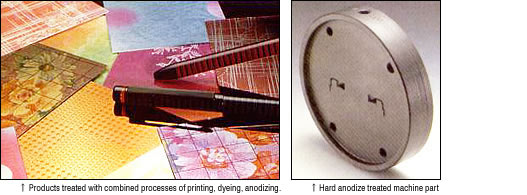#083 Anodizing
Previously, electro and electroless plating were discussed. Anodizing process for light metals will be discussed from this volume.
Anodizing is a surface treatment process of creating an oxidized surface layer by an electrolysis process where the subject part is made and anode (+ pole) in an electrolyte solution. Processed aluminum and its alloy parts are called by well know name of "Alumite".
The anodizing process using various electrolytes such as sulfuric acid, oxalic acid, chromic acid, or organic acid, as well as different temperatures and power source electrical waveforms will produce surface layers of different properties.
The oxygen produced at the anode produces porous layer with good electrical isolation characteristics, corrosion resistance, and wear resistant properties. The layer porosity is utilized for coloring as well as various functions added, and used for products such as reflector plates, household pots and pans, construction materials, automotive components, machinery/optical/communications, and computer components.
In addition to aluminum, anodizing is used on magnesium, titanium, and tantalum, but are not for the same purpose as the processes on aluminum but for electrical components such as capacitors utilizing the nature of the surface oxidation layers.
The layers created by the anodizing process can be classified into two categories. One is the former Porous Layer Type represented by the "Alumite Process", and other is the Barrier Type used for capacitors. The layer properties for these two are completely different. In our discussion, the Porous Layer Type" will be explained for our purpose of Surface Treatment subject.

- Environmental conservation
- Hot Dipping
- Anodic Oxidation Process
- Anodic oxidation treatment
- Anodizing
- Corrosion - Corrosion Protection
- Electroless Plating
- Electroplating
- Heat treating
- Hydrogen embrittlement
- Metal cleaning
- Metal etching
- Painting
- Special paints
- Surface Treatment
- Surface-treated steel sheets
- Thermal Spraying



